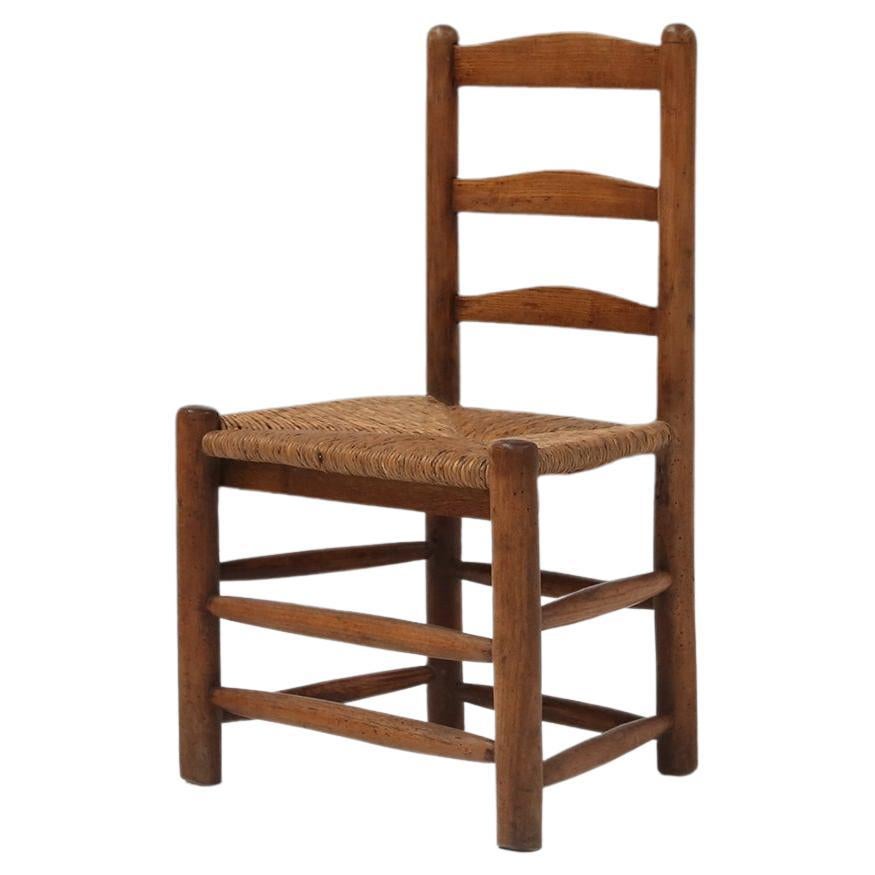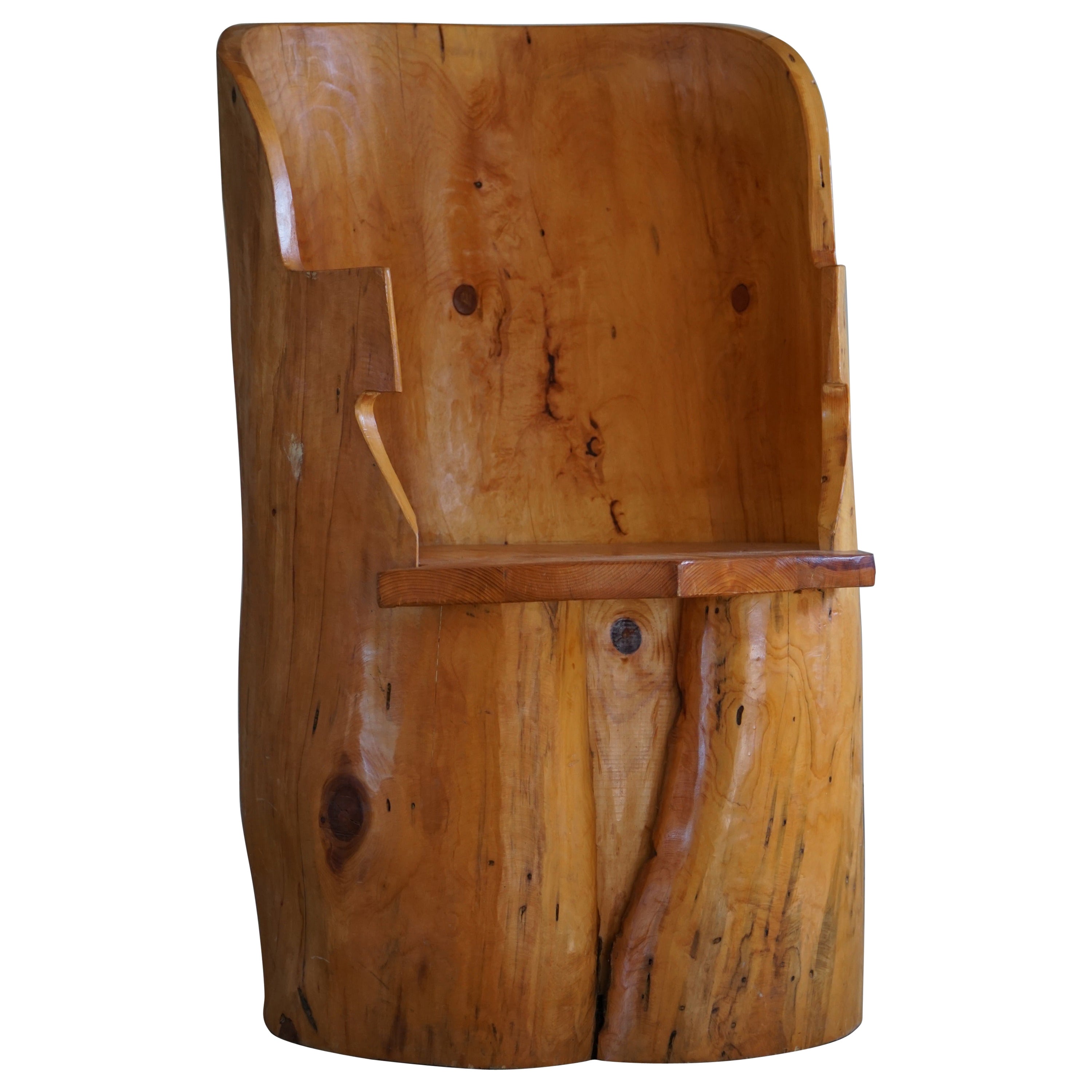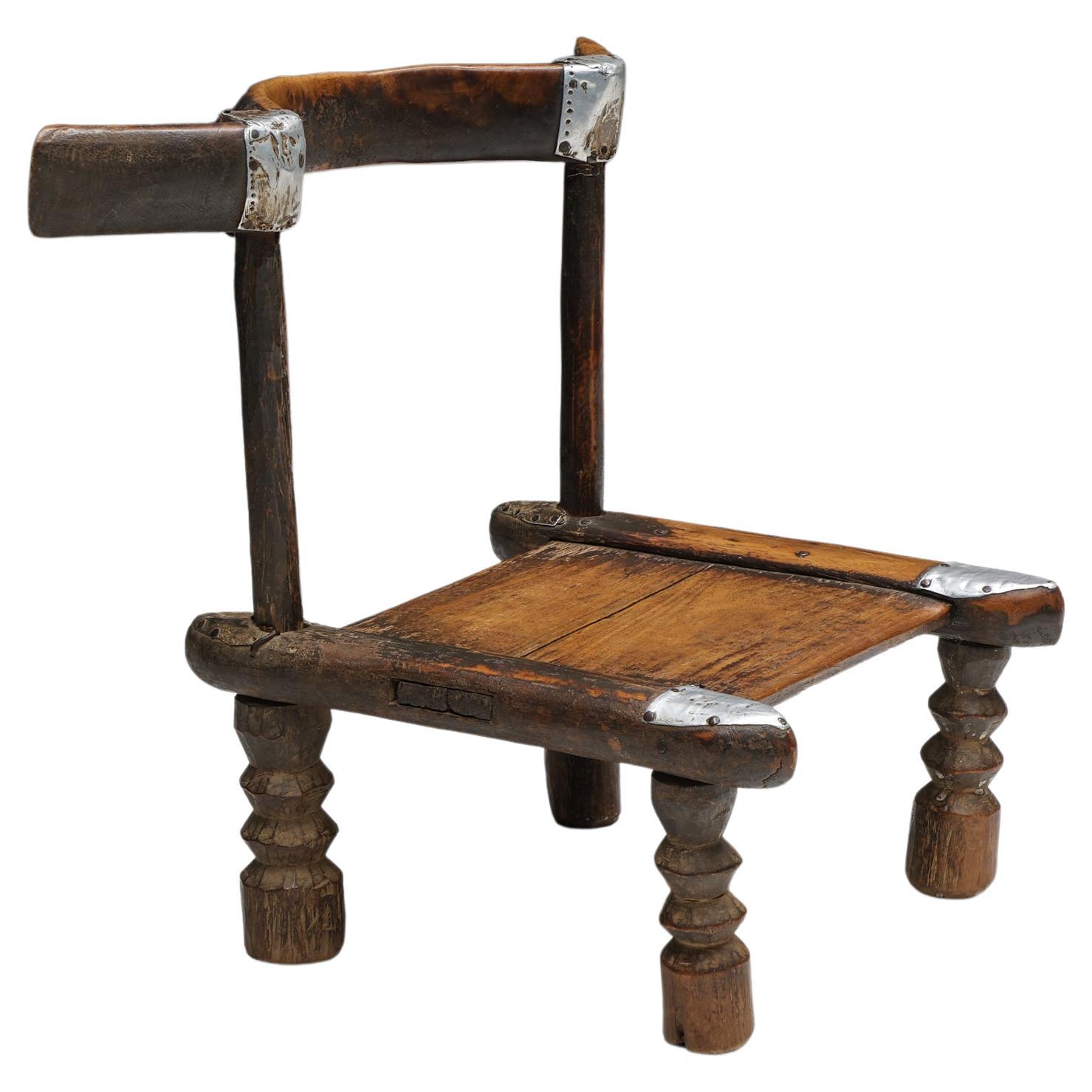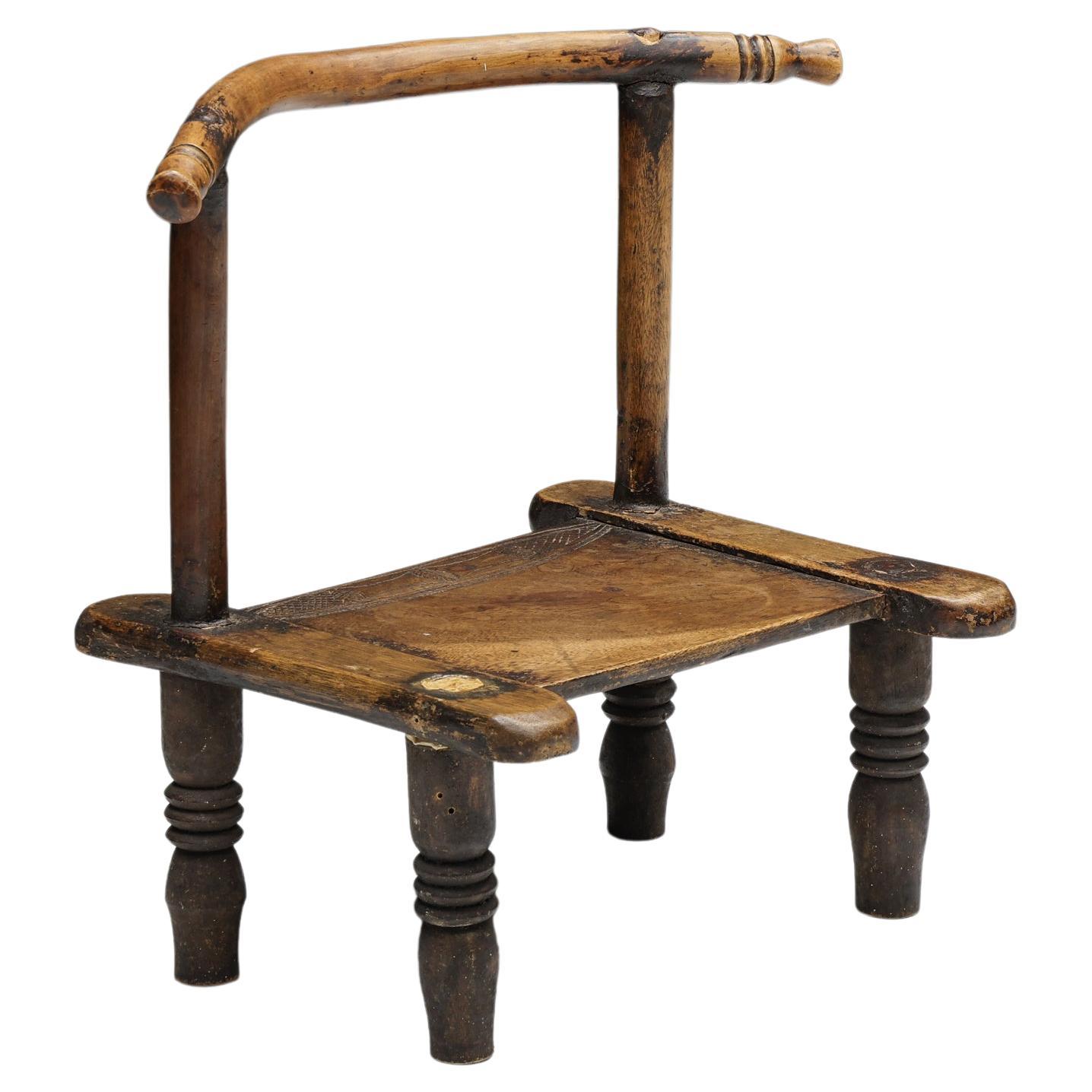Items Similar to French Wabi Sabi brutalist side chair 1950’s
Want more images or videos?
Request additional images or videos from the seller
1 of 6
French Wabi Sabi brutalist side chair 1950’s
About the Item
Rare brutalist wabi sabi side chair made in the mountains of France in the 1950’s in solid wood.
The chair is in good original condition with a beautiful patina.
The chair is the perfect detail for any style of interior from the traditional Scandinavian style of interior to a more modern style of interior or even a more Wabi Sabi style of interior.
Brutalist architecture is an architectural style that emerged during the 1950s in the United Kingdom, among the reconstruction projects of the post-war era. Brutalist buildings are characterized by minimalist constructions that showcase the bare building materials and structural elements over decorative design. The style commonly makes use of exposed, unpainted concrete or brick, angular geometric shapes and a predominantly monochrome color palette, other materials, such as steel, timber, and glass, are also featured. Descending from the modernist movement, brutalism is said to be a reaction against the nostalgia of architecture in the 1940s. Derived from the Swedish phrase nybrutalism, the term "new brutalism" was first used by British architects Alison and Peter Smithson for their pioneering approach to design. The style was further popularized in a 1955 essay by architectural critic Reyner Banham, who also associated the movement with the French phrases béton brut ("raw concrete") and art brut ("raw art"). The style, as developed by architects such as the Smithsons, Hungarian-born Ernő Goldfinger, and the British firm Chamberlin, Powell & Bon, was partly foreshadowed by the modernist work of other architects such as French-Swiss Le Corbusier, Estonian-American Louis Kahn, German-American Mies van der Rohe, and Finnish Alvar Aalto.
In the United Kingdom, brutalism was featured in the design of utilitarian, low-cost social housing influenced by socialist principles and soon spread to other regions around the world. Brutalist designs became most commonly used in the design of institutional buildings, such as universities, libraries, courts, and city halls. The popularity of the movement began to decline in the late 1970s, with some associating the style with urban decay and totalitarianism.
Brutalism has been polarizing historically; specific buildings, as well as the movement as a whole, have drawn a range of criticism (often being described as "cold" or "soulless") but have also elicited support from architects and local communities (with many brutalist buildings having become cultural icons , sometimes obtaining listed status). In recent decades, the movement has become a subject of renewed interest. In 2006, several Bostonian architects called for a rebranding of the style to "heroic architecture" to distance it from the negative connotations of the term "brutalism".
- Dimensions:Height: 33.47 in (85 cm)Width: 13.78 in (35 cm)Depth: 14.77 in (37.5 cm)Seat Height: 17.33 in (44 cm)
- Style:Brutalist (Of the Period)
- Materials and Techniques:
- Place of Origin:
- Period:
- Date of Manufacture:1950’s
- Condition:Wear consistent with age and use.
- Seller Location:Valby, DK
- Reference Number:1stDibs: LU6559235174712
About the Seller
5.0
Vetted Seller
These experienced sellers undergo a comprehensive evaluation by our team of in-house experts.
1stDibs seller since 2022
25 sales on 1stDibs
Typical response time: <1 hour
- ShippingRetrieving quote...Ships From: Valby, Denmark
- Return PolicyA return for this item may be initiated within 2 days of delivery.
More From This SellerView All
- Swedish wabi sabi style folk art chairLocated in Valby, 84Rare Swedish folk art chair in solid dark stained wood made by a very talented craftsman in the middle of the 19th century in Sweden. The chair has some beautiful details like the v...Category
Antique Mid-19th Century Swedish Folk Art Side Chairs
MaterialsWood
- French organic brutalist wabi sabi style coffee table 1950'sBy José Zanine CaldasLocated in Valby, 84Rare and possibly unique coffee table made by a very talented french craftsman in France in the 1950's. The table has beautiful visible joints on the table top, the table has great o...Category
Vintage 1950s French Brutalist Coffee and Cocktail Tables
MaterialsHardwood
- Mogens Koch Side Chair and StoolBy Mogens KochLocated in Valby, 84Rare side chair and stool designed by Mogens Koch in the 1930’s for the office’s at Skive & Sønderborg stats hospital. The chair and stool is made in solid beech wood and has been re...Category
Vintage 1930s Danish Scandinavian Modern Side Chairs
MaterialsBrass
- Side Chair by Danish Artist Jørgen Roed, Denmark 1840’sLocated in Valby, 84Rare and uncommon side chair crafted attributes to renowned artist Jørgen Roed in Denmark during the 1840s. With its exquisite craftsmanship and historical significance, this chair i...Category
Antique 1840s Danish Other Side Chairs
MaterialsWool, Mahogany
- Pair of sculptural Henry Kjærnulf oak side chairs, Denmark 1960’sBy Henning Kjærnulf, Nyrup MøbelfabrikLocated in Valby, 84Set of two of very sculptural solid oak side chairs with original striped wool upholstery designed by Danish designer Henry Kjærnulf also known as Henning Kjærnulf and manufactured b...Category
Vintage 1960s Danish Scandinavian Modern Side Chairs
MaterialsWool, Oak
- Tall Swedish organic wooden wabi sabi style sculptureLocated in Valby, 84Rare big wabi sabi style sculpture made in Sweden in the 1970’s. The sculpture is hand crafted by talented Swedish artist in solid wood which has been partially stained and mounted ...Category
Vintage 1970s Swedish Folk Art Abstract Sculptures
MaterialsMetal
You May Also Like
- Brutalist Wabi Sabi Tripod Alpine Chairs, France, 19th CenturyLocated in Antwerp, BEBrutalist alpine chairs, testifying to the raw beauty of the imperfect wabi wabi. Despite their identical origins, each chair has its own unique imperfections, reinforcing their conn...Category
Antique 19th Century French Brutalist Side Chairs
MaterialsWood
- French rustic Wabi-Sabi chair 1850Located in Meulebeke, BERustic wooden chair made around 1850 in France. This chair in Wabi-Sabi style has a great patina and is perfect for a side chair in any interior. Made of solid wood and a rattan seat.Category
Antique 1850s French Rustic Side Chairs
MaterialsWicker, Wood
- Rustic Wabi Sabi Rattan Chair, France, 1940sLocated in Antwerp, BERustic; Wood; Cord; Wabi Sabi; Rattan; dining chair; side chair; France; French Craftsmanship; 1940s; Mid-Century Modern; Rustic chair with comfortable cord seating and an imperfec...Category
Vintage 1940s French Rustic Chairs
MaterialsCord, Wood
- Stump Chair in Solid Birch by a Swedish Cabinetmaker, Wabi Sabi, 1950sLocated in Odense, DKCharming primitive stump chair made in solid birch. Hand carved by a Swedish cabinetmaker. A nice wabi sabi piece, perfectly sutied for the modern interior. This modern armchair w...Category
Mid-20th Century Swedish Brutalist Armchairs
MaterialsBirch
- Robust Wabi-Sabi Chair, France, 20th CenturyLocated in Antwerp, BEFrench rustic folk art wooden chair, embodying the essence of wabi-sabi philosophy. Crafted with meticulous artistry, this piece is a unique expression of organic beauty, boasting re...Category
20th Century French Rustic Chairs
MaterialsWood
- Wabi-Sabi Sculptural Chair, France, 20th CenturyLocated in Antwerp, BEFrench rustic folk art wooden chair, embodying the essence of wabi-sabi philosophy. Crafted with meticulous artistry, this piece is a unique expression of organic beauty, boasting re...Category
20th Century French Rustic Chairs
MaterialsWood
Recently Viewed
View AllMore Ways To Browse
Antique Spanish Side Chair
Antique Empire Side Chairs
Bamboo Chairs Game Table
Office Chair Striped
Louis Philippe Parlor Chairs
Marcel Breuer Cesca Bar Chair
Bar With Seating
Front Bar Back Bar
Walnut Office Chair
Antique Front And Back Bar
Striped Fabric Side Chair
Bar Rail Mid Century
Pair Of Antique Chinoiserie Chairs
Burlwood Biedermeier
Side Chair Painted
White Chair For Bedroom
Grey Bar Chair
White Velvet Side Chair





